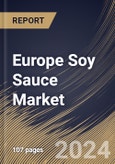Blended soy sauce, a common variant in the market, combines brewed sauce with other ingredients such as hydrolysed vegetable protein, caramel colour, and preservatives. This type of sauce is known for its consistent flavour profile, affordability, and versatility in culinary applications. Blended sauce often caters to a wider consumer base, offering options with varying levels of saltiness, sweetness, and viscosity to suit different taste preferences. Therefore, the France market consumes 88.6 kilo tonnes of Blended soy sauce in 2022.
The Germany market dominated the Europe Soy Sauce Market by Country in 2022, and would continue to be a dominant market till 2030; thereby, achieving a market value of $3,769.4 million by 2030. The UK market is exhibiting a CAGR of 4.9% during (2023 - 2030). Additionally, The France market would experience a CAGR of 6.7% during (2023 - 2030).
The market, a cornerstone in condiments, has witnessed remarkable growth and transformation over the years. Rooted in Asian culinary traditions, sauce has transcended its origins, becoming a flavor enhancer and a key ingredient in diverse cuisines. As travel and trade expanded, found its way into kitchens all over. Today, it is a staple in households, restaurants, and industrial kitchens, showcasing its adaptability and broad appeal.
The rich umami taste and the ability to complement a wide array of dishes have contributed to sauce’s status as a pantry essential across continents. In addition, the versatility of sauce is evident in its extensive range of applications across various culinary domains. This is in line with the growth of the food industry across various nations. For instance, as per the data from the Government of the United Kingdom, the UK is known for its traditional and contemporary food and drink offerings.
With rising disposable income, consumers in the EU are more inclined to explore diverse cuisines, including Asian and international flavors. As per the data released by Eurostat, in 2022, the median equivalized disposable income in the EU was 18,706 purchasing power standards (PPS) per inhabitant, increasing from 18,011 PPS recorded in 2021. Belgium (24 142 PPS), Denmark (23 244 PPS), Luxembourg (33 214 PPS), the Netherlands (25 437 PPS), Austria (25 119 PPS), and Germany (23 197 PPS) were the EU member states with the highest national median disposable incomes in 2022. Thus, the rising numbers of e-commerce platforms and disposable income in Europe will assist in the expansion of the regional market.
Based on Type, the market is segmented into Blended and Brewed. Based on Application, the market is segmented into Food Industry and Household. Based on countries, the market is segmented into Germany, UK, France, Russia, Spain, Italy, and Rest of Europe.
List of Key Companies Profiled
- Bourbon Barrel Foods LLC
- Lee Kum Kee Company Limited
- Otafuku Sauce Co., Ltd.
- Yamasa Corporation
- Aloha Shoyu Company
- Guangdong Meiweixian Flavoring Foods Co., Ltd.
- Nestle S.A.
- Masan Group Corporation
- Kikkoman Corporation
- Foshan Haitian Flavoring & Food Co., Ltd.
Market Report Segmentation
By Type (Volume, kilo Tonnes, USD Billion, 2019-2030)- Blended
- Brewed
- Food Industry
- Household
- Germany
- UK
- France
- Russia
- Spain
- Italy
- Rest of Europe
Table of Contents
Companies Mentioned
- Bourbon Barrel Foods LLC
- Lee Kum Kee Company Limited
- Otafuku Sauce Co., Ltd.
- Yamasa Corporation
- Aloha Shoyu Company
- Guangdong Meiweixian Flavoring Foods Co., Ltd.
- Nestle S.A.
- Masan Group Corporation
- Kikkoman Corporation
- Foshan Haitian Flavoring & Food Co., Ltd.
Methodology

LOADING...









